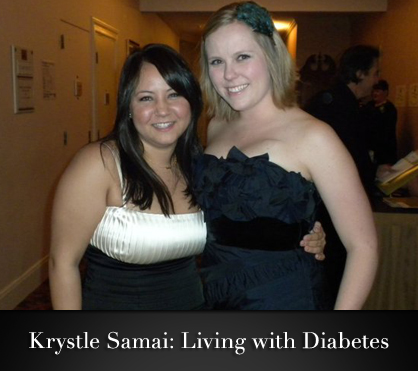American Diabetes Month: One girl’s story of struggle
Most people worry about forgetting their cell phone when dashing out the door. Krystle Samai always checks to make sure she has her insulin pump. Diagnosed with Type 1 diabetes as a child, she has learned the hard way to always be prepared. Diabetes patients must check their blood sugar at least four times per day. Samai finds herself testing more like 15 times.
“That’s the only way I know what is going on with my body. I am incredibly aware and I have to be,” she maintained. “It’s impossible to take a vacation from … Every day, there’s never more than an hour or two that passes that I don’t think I wonder what my blood sugar is like right now.”
More than 25.8 million Americans, including 215,000 under age 20, have Type 1 or Type 2 diabetes. All forms of diabetes are serious, often leading to major issues such as heart and kidney disease, amputation, blindness, early death and more. Two out of every three people with diabetes die from heart disease or stroke.
Samai’s story begins at age 9. She was losing weight, very thirsty and loved to take naps, so her mother knew something was wrong. She carted her off to a doctor, who told her the sad news.
A very scared Samai was taken to the hospital, where she learned to give herself shots. “I remember thinking I couldn’t do this for the rest of my life … I remember feeling really scared,” she said.
She didn’t know much about diabetes, but she did know it would be a major life change. She had heard horror stories of blindness and amputations, which are more typical of Type 2.
Now, after 17 years, she cannot remember life before the disease.
“There are moments when it is a pain in the butt when you are low and you want to go for a run and you want to be healthy and you want to do things with friends and you want to go on the hike. There’s times when it really cramps my style,” she noted.
When her blood sugar is low, she needs to eat. When it is high, she needs to take insulin. This means always being prepared with a sugary snack and her insulin pump.
Low blood sugar can strike fast – even in the middle of the night – and sometimes Samai misses the mild symptoms such as shakiness and sweating. Seizures can strike equally easily.
“You try to eat the right things, you try to measure everything, but sometimes it happens. I’ve had a handful of really bad blood sugars that have resulted in seizures … The hardest part is feeling confident that I am going to be okay. And that I can do this on my own,” she maintained.
Type 1 typically affects the younger generation. The pancreas makes the insulin hormone, which allows cells to use glucose for energy. In Type 1, the body’s immune system destroys cells in the pancreas and patients must inject themselves daily with insulin or an infusion pump, or their cells will die and glucose will build up in the blood, causing further harm.
Type 2, which is more common, starts with insulin resistance, in which the cells do not appropriately use insulin, causing the pancreas to produce less glucose and the insulin to become less effective at regulating blood sugar.
“(Diabetes) affects a huge number of people and continues to grow, both Type 1 and Type 2, and we can’t seem to control it. Our society is out of control with overeating and under-exercising,” Shelley Yeager, director of outreach and education at the Diabetes Education and Camping Association, said, noting this does not apply to Type 1.
Diabetes is a growing health crisis in our country. Researchers estimate up to one in three American adults will develop diabetes by the year 2050.

via Krystle Samai
Despite all the numbers and facts, the real tragedy is Type 2 can be prevented. While the cause of Type 1 is largely unknown, experts estimate Type 2 can be prevented simply by eating a healthful diet and exercising regularly. Type 1 strikes randomly, leading to serious health problems and even early death.
From the emotional strain to the financial burden, diabetes is a difficult disease to bear.
“I do not think the public understands how difficult it is to live with diabetes. It’s not a ‘visual’ condition. People who have diabetes look ‘normal.’ Or worse, they are blamed for getting the condition themselves,” Yeager, who has worked in the diabetes field for 25 years, said.
On the other hand, as Samai notes, it is “not cancer.” It is possible to live a healthy, long life while eating a balanced diet and monitoring blood glucose levels.
“It’s diabetes. This is manageable and livable,” she emphasized.
Every day can bring frustration: doing everything right and still experiencing blood sugar difficulties, for no apparent reason.
“Living with diabetes places frequent and rigorous demands on a child – blood glucose monitoring, insulin adjustment and administration by injection or infusion, careful meal planning … It is easy for a child to feel alone with their disease,” Yeager said.
Diabetes camps, such as the 400 camping programs provided by the Diabetes Education and Camping Association, can help make a child feel less alone and provide the support and encouragement needed to tackle the challenges of living with the disorder.
Attending camp was the first time Samai felt normal. She described meeting peers who understood the experience of being made fun of for drinking Diet Coke. The decision to return as a counselor was an easy one.
“When you are younger, it is hard because you want to be like everybody else. You don’t want to be different. And diabetes makes you different,” Samai said.
Promising treatments may be on the horizon, such as a procedure to transplant pancreas cells and a “closed loop” insulin pump system that would eliminate the need for patients to administer the needed dose based on their bodies’ blood sugar level.
“It would be great to have a cure for diabetes, of course, but I am okay right now,” Samai said. “It takes a little extra work, but I think a lot of times people don’t see themselves as a normal human being. They think they are sick or something is wrong. Yeah, sure, my pancreas doesn’t work properly, but I’m okay. I am just fine.”
In the end, Samai says the important thing is that her disease is not holding her back.
“I can do anything,” she declared. “I can do everything that I want to do, diabetes does not limit me. This isn’t a curse … Diabetes hasn’t stopped me from doing anything. It’s just added motivation to really just make sure I put my health first, because without my health I have nothing.”
For more information on diabetes, visit www.diabetes.org. To find a diabetes camp near you, visit www.diabetescamps.org.
Tagged in: lux exclusives, charity, nonprofit, philanthropy, disease, diabetes, type 1, type 2,

LadyLUX via istock



